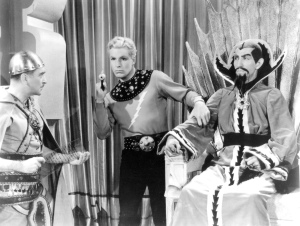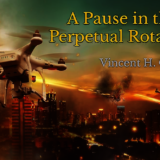“THE BIG SHUTDOWN,” a space western novel with a difference, is out this week. Author John M. Whalen, a frequent Amazing Stories contributor, tells us exactly what that difference is.
When people ask me to explain what The Big Shutdown is, I tell them: “It’s like Flash Gordon meets Randolph Scott and Sam Peckinpah out on Route 66, but on another planet, a few hundred years in the future.” They sort of look at me and go “huh?” I can’t blame them. It sounds like an overly complicated answer to a simple question, but it isn’t, really, because, even though The Big Shutdown seems like a simple little space opera, it’s more complicated than that. It came about in an unusual way.
It originated as a story for the fondly remembered Ray Gun Revival ezine. RGR was basically a labor of love undertaken by three people, “Overlords” Johne Cook, L.S. King, and Paul Christian Glenn. It was dedicated to presenting the kind of Space Opera stories you couldn’t find back in 2006. When I found out they were open to submissions, I sent them a story that I had previously had published in the now dormant www.pulpanddaggerfiction.com. It was called “Tulon Station.”
What it was, was a rewrite of my favorite western of all time, “Comanche Station,” a Randolph Scott film directed by Budd Boetticher. I took the basic  idea of Burt Kennedy’s script and redid it as a science fiction story. Not the first time this has been done. John Sayles rewrote Akira Kurosawa’s “Seven Samurai”, and John Sturges’ “The Magnificent Seven” as the sci fi flick “Battle Beyond the Stars” (And we all know Fistful of Dollars was a rewrite of Yojimbo). I wanted to see if I could do the same thing. I set Boetticher’s story a couple hundred years in the future and invented a planet called Tulon, that was rich in oil and had been a boom planet, like a boom town in the old west. But times had changed. The need for oil became a thing of the past as alternative fuels were developed, and Tulon became the victim of “The Big Shutdown” by the oil companies that had exploited it.
idea of Burt Kennedy’s script and redid it as a science fiction story. Not the first time this has been done. John Sayles rewrote Akira Kurosawa’s “Seven Samurai”, and John Sturges’ “The Magnificent Seven” as the sci fi flick “Battle Beyond the Stars” (And we all know Fistful of Dollars was a rewrite of Yojimbo). I wanted to see if I could do the same thing. I set Boetticher’s story a couple hundred years in the future and invented a planet called Tulon, that was rich in oil and had been a boom planet, like a boom town in the old west. But times had changed. The need for oil became a thing of the past as alternative fuels were developed, and Tulon became the victim of “The Big Shutdown” by the oil companies that had exploited it.
Against this backdrop I set my character, Jack Brand, an ex-Army Ranger and former officer of the Trans-Exxon Security Force. In “Commanche Station,” Randolph Scott was looking for a wife kidnapped by Indians. In my story, Brand is searching for his sister, a fellow member of the security force, who got captured by Nomads, the dregs of what was left of Tulon society during the Shutdown.
The folks at Ray Gun liked the tale, and were set to publish it, when I suggested they hold up. The story, like the film, left unanswered the question of whether the hero ever finds what he’s looking for. So I wrote another story that resolved that question (no spoilers here). The Ray Gunners, being the cool people that they are, dug it and were ready to run the two stories consecutively.
Then I got the bright idea that there was a lot more story to tell concerning events that happened between the first and last story. I suggested writing more tales to fill the gap. It just so happened that the Overlords needed material. At the time there weren’t too many people writing the kind of story that fit their unique space opera/space western requirements. So I started writing and over 18 months came up with a dozen stories. Each story was a stand alone, but had the overriding through line of Brand’s search for his missing kid sister.
I wrote it like a television series. Each story was basically like an hour long show. Some of the tales have interesting origins. Aside from the Boetticher/Kennedy/Scott influence, the stories were also an homage to a TV series that ran in the 1960s. “Route 66” (1960-1964 on CBS) ran for 116 episodes. It was created and written for the most part by Stirling Silliphant, the writer who later would get an Oscar for “In the Heat of the Night,” and was hugely successful for years in Hollywood. He wrote 70 of those hour long shows. The man was a genius. So many of the scripts were so good, Washington Post TV critic Tom Shales called it “one of the best written shows of its day, maybe any day.”

The stories are like nothing on TV now. They had interesting characters with unique problems. There weren’t any plots. Silliphant said he favored continuity over plot. But his scripts kept you riveted to the screen week after week. The characters he wrote about, in a phrase now out of fashion, “hit you where you live.” You could get hung up on people searching for their identities, the meaning of life, searching for love, a place to belong, all that type of stuff.
I could go on and on about this show, but let’s get back to “The Big Shutdown.” In putting the Jack Brand stories together month by month, I dug back in my psyche for memories of the “route 66” shows for inspiration. Characters such as Calystra, the psychic plagued by the visions that invade her mind, Cassidy, a former security team member and friend of Brand who crash lands in the jungle, and Rev. Thomas, the minister of a religious cult who lost his faith in himself and his religion, all were inspired by the kinds of off-center characters who showed up on “route 66.”
There were other influences. The story “Tulip,” was inspired by a Sam Peckinpah script that he wrote for The Westerner TV series in 1960. I wasn’t the only one to rip that story off. Robert Culp rewrote it as “The Loser” episode  of I Spy, starring Eartha Kitt. “The Secret Treasure of Dar Zul,” was actually inspired by a Hopalong Cassidy flick that had Hoppy leading explorers to some Mayan ruins. Another of the stories, “The Eight Arms of Death,” is my homage to the Buster Crabbe Flash Gordon serials.
of I Spy, starring Eartha Kitt. “The Secret Treasure of Dar Zul,” was actually inspired by a Hopalong Cassidy flick that had Hoppy leading explorers to some Mayan ruins. Another of the stories, “The Eight Arms of Death,” is my homage to the Buster Crabbe Flash Gordon serials.
The key ingredient throughout is that although it’s a science fiction tale, it’s written as a western. It’s set on a planet that greatly resembles the American Southwest of the 1880s, give or take a domed city or two. The Jack Brand character is modeled on Randolph Scott and the dialog is in the tradition of pulp westerns. The action scenes play, I hope, like some of Peckinpah’s gritty set pieces.
When the series ran its course, I did some editing and rewriting later to turn the stories into an episodic novel. It was published by a small press that has since shut its doors. The book has been out of print since 2013. When I discovered that used copies of “Jack Brand” were being sold on the Internet, and after a publisher offered to reprint it, I decided instead to put it out under my own Flying W Press.
Space opera is having a resurgence these days, and there are even some that are called space westerns, including Star Wars. But examples of real space westerns are actually few and far between. “The Big Shutdown,” written almost 10 years ago, is what I like to think of as one of the purest examples of the genre.
So that’s the whole story of how this book came about. Like I said, it’s like Flash Gordon meets Randolph Scott and Sam Peckinpah out on Route 66, only on another planet, a few hundred years in the future.
The book is available on Amazon here. Flying W Press’ press release can be found here.











